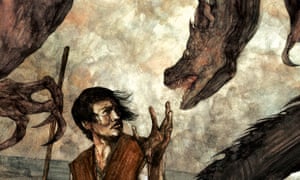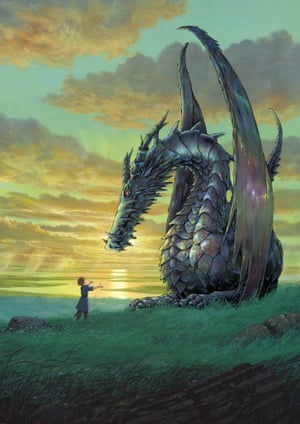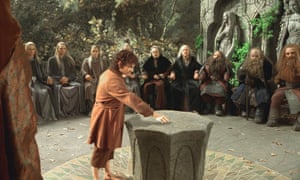Four principal wizards inhabited my childhood. These were, in order of discovery, TH White’s Merlin, JRR Tolkien’s Gandalf, Susan Cooper’s Merriman Lyon and Ursula K Le Guin’s Ged, more commonly known as Sparrowhawk, true names being a serious business in Earthsea. Other magicians and witches also lived on my boyhood bookshelf, but even at 10 years old I sensed that these belonged to a lesser order. Growing up, I adored A Wizard of Earthsea, Le Guin’s slim but muscular 1968 novel, which I read and reread until my ratty old paperback copy required emergency surgery, and I still have a precious memory of getting to the last page for the umpteenth time, staring at the final line – “and Yarrow ran to meet them, crying with joy” – and realising with a giddy clarity that being a goalkeeper or inventor or forester was yesterday’s news, and that I had to be a writer and nothing else would do. I yearned to do to other people what A Wizard of Earthsea had just done to me – even if I couldn’t articulate exactly what that was. Adulthood brings more demanding critical standards and many a childhood favourite has been booted off my podium of most cherished books, but my admiration for Le Guin’s artistry has only grown with every rereading.
First, there is the titular wizard himself. Ged is a superb creation, by any measure, and was the Archmage of my bookshelf even before he became the Archmage of Earthsea. He was by far the easiest wizard to relate to, and the least derivative I knew. Not to belittle TH White’s, Tolkien’s or Susan Cooper’s wizards (never belittle a wizard of any stripe), but they are variants on the archetype of Merlin, a Caucasian scholarly aristocrat amongst sorcerers, who appears fully formed and with little room for character development. Where the Merlins reveal themselves layer by layer, Ged grows. Each section of the novel is a stage in “Ged’s Progress”: from a village lout called Duny in Ten Alders, “wild, a thriving weed, a tall, quick boy, loud and proud and full of temper”, to an impatient apprentice at Re Albi, hungry for power for its own sake, to a brash student on Roke prone to inverted snobbery, to a chastened survivor on Low Torning and Pendor, to a guest in a trap on wintry Osskil, to a fugitive returning to Gont, and finally to a hunter going to his own death. The narrative is powered by Ged’s vices and virtues, and this intertwining of character and plot gives A Wizard of Earthsea an inherent rightness, like a progression of unexpected yet satisfying chord changes. Any reader with experience of adolescence will recognise herself, or himself, in Ged’s portrait, and because we identify with Ged’s failings, we worry for him, can hardly bear to look when disaster hits, and afterwards care deeply about his fate.
Compared to Ged, the novel’s other characters are minor ones in terms of “screen time” and only three appear in more than one episode of Ged’s life: Ogion the Silent, Ged’s master on Gont; Vetch, a friend who sometimes knows Ged better than Ged knows Ged; and Serret, an ill-intentioned sorceress. Yet even the characters that appear most fleetingly seem to be endowed by Le Guin with a fully thought-out inner life, so that when they speak, act and respond, they do so as human beings who have lived lives as full, broken, light, dark, messy and real as Ged’s and ours. Here a fisherman named Pechvarry, whose dying son Ged tried but failed to save, meets the young wizard on his victorious return from Pendor: “‘I did not know you were so mighty, my lord.’ There was fear in that because he had dared make Ged his friend, but there was reproach in it also. Ged had not saved a little child, though he had slain dragons.” How human this brief passage makes Pechvarry, how conflicted, and how visible it makes his scars. Le Guin’s thumbnail sketches contain the psychological depth of oil paintings. The notion that these people on the periphery of Ged’s story aren’t real never crosses my mind. Pechvarry et al. are still out there in their corner of Earthsea, getting on with their lives
As for the titular wizard, so for his titular world. “The rhythmic structure of narrative is both journey-like and architectural,” Le Guin has written. “Great novels offer us not only a series of events, but a place, a landscape of the imagination which we can inhabit and return to. This may be particularly clear in the ‘secondary universe’ of fantasy, where not only the action but the setting is avowedly invented by the author.” Earthsea is an archipelago, dense with islands at its centre and sparser at its edges, and after my first reading, it joined Tolkien’s Middle-earth to form an elite fantasy-world super-league of two. (George RR Martin’s Westeros has since made it three, but CS Lewis’s Narnia feels too fey and allegorical to qualify.) Tolkien, whose influence Le Guin acknowledges, casts a long shadow over 20th-century fantasy, and yet (after donning my riot gear) I would argue that Earthsea is a superior creation to Middle-earth. No territory is as fertile as virgin territory, but Tolkien’s sylvan elves, earthy dwarves, cod-Arthurian knights, scrotum-faced orcs and Dark Lords in implausible towers have ossified into cliche.
Earthsea is a fantasy world, and proud of it, mapped by its creator in 1966–7 on a large sheet of butcher’s paper with crayons in a house full of young children. Earthsea has magic, dragons, its own myths and prehistory; but its magic is weighted with metaphysics, its dragons are psychodragons of air and mind, more akin to dangerous Chinese sages than Tolkien’s Smaug; and Earthsea is so human a world – with trade-routes, local politics, class hierarchies, infant mortality, abuse, addiction and slavery – that its fantastical elements feel almost quotidian. Even Earthsea’s islands, with names such as Atnini, Komokome, Selidor and the Isle of the Ear, have a habit of morphing into islands in each reader’s memory: the Hebrides, the Cyclades, the islands of the Seto Inland Sea, or Hawaii.
Earthsea is no utopia, but it contains utopian elements. (Not coincidentally, Le Guin is also the author of 1974’s The Dispossessed, one of world literature’s few utopias built from the real “crooked timber” of humanity.) By and large, Earthsea is a secular world. Its cosmology is deeply rooted and widely believed, but no priest-caste feeds off it, with the exception of the Kargad Empire’s warlike theocracy whose raid on Gont prompts Sparrowhawk’s first serious act of magic. The Kargad exception proves the rule: the Archipelago has room for animism, possible reincarnation and a Hades-like afterlife, but not for churches, mosques, synagogues or shrines, and Earthsea is a more peaceful world than Earth as a consequence. What we now call cultural relativism is a widely held tenet. Slavery exists but is unrelated to skin tone, and racism is not in evidence; nor a caste-system, nor colonisation, nor nationalism. In contrast to Tolkien’s Middle-earth, where what is western and white is good, Earthsea’s Arians, the Kargad raiders, are “a savage people, white-skinned, yellow-haired, and fierce, liking the sight of blood and the smell of burning towns”. Ged’s skin is copper-brown, “like most Gontishmen”; his friend Vetch would pass as a sub-Saharan African; and in the third book of Earthsea, The Farthest Shore, Ged will owe his life to a “floating tribe” of raft people in the Southern Reach whose Polynesian-inflected folkways match their complexions.
Le Guin records the variations in customs and protocol across the regions of Earthsea with an ethnographer’s eye:
“Lord Wizard,” the girl greeted him, and decorously she bobbed her head and hid her eyes with her hands to show respect, as women did in the East Reach; her eyes when not hidden were clear, shy, and curious.
Such specificity is persuasive because it sounds too detailed to be made up. Connections are often drawn between Le Guin’s anthropological exactitude, her cultural relativism and the work of her father, Alfred L Kroeber, the first professor appointed to the department of anthropology at the University of California; and Le Guin herself has described a formative milieu, illuminated by her father’s colleagues, friends and Native American “informants”:
I grew up in this weird household where we were completely middle-class Americans, but the doors and windows were always open to other ways of living. And that was, I think, the most unusual thing in my upbringing … A consciousness that “We live this way, but it’s not the only way to live.” And that opened my doors and windows to imagining other societies, other planets … different futures, and so on.
This notion that “other ways of living” are as valid as one’s own, and should be learned from rather than conquered or exploited, is key to the Archipelago’s collective consciousness – and is another reason why I love to revisit the place.
Style and voice are the Scylla and Charybdis of fantasy novels, where many authors of duller literary gifts than Le Guin’s come undone. Quality writing within genre is harder, not easier, because the ground is so mined with cliche. A cod-historic narratorial voice in a fantasy novel feels like being locked inside a medieval theme park; neologisms will jar – one use of “totally awesome” will puncture a fantasy world; but a studied neutrality of style tastes like clingfilm. What is needed is a high-wire balancing act, which Le Guin pulls off with deceptive effortlessness. Ged’s story is told with the calm authority of an age-old Icelandic saga, yet stitched here and there with passages of pure beauty for its own sake. Like this one, when Ged arrives at a School for Wizards (three decades before one H Potter) on the island of Roke and encounters the Archmage:
As their eyes met, a bird sang aloud in the branches of the tree. In that moment Ged understood the singing of the bird, and the language of the water falling in the basin of the fountain, and the shape of the clouds, and the beginning and end of the wind that stirred the leaves: it seemed to him that he himself was a word spoken by the sunlight. Then that moment passed, and he and the world were as before, or almost as before.
Metaphors and similes are scarce enough to burn vividly when they do appear, and dialogue is sparing. Descriptions of people and places are rich enough to nourish the reader’s imagination, but frugal enough to allow it to collaborate in the act of creation. Earthsea’s accents and dialects are referred to but not reproduced on the page, and Le Guin eschews wide variations of tone or register. Dialogue contains warmth and humour, but no knowing wisecracks. There are moments of foreshadowing and authorial omniscience but no tricks. Consequently, A Wizard of Earthsea reads like the retelling of a tale first told centuries ago, and whose twists and turns have been handed down through generations of storytellers. It is timeless.
If Earthsea is one of literature’s best-written fantasy worlds, it is also one of the most cerebral. Chief among its concerns are morality, identity and power. In The Farthest Shore the Master Patterner on Roke will ask Ged, “What is evil?” and be answered, “A web we men weave,” but the seed of this theme is germinating in A Wizard of Earthsea. From Beowulf to Tolkien, to countless formulaic fantasy movies at a multiplex near you, the genre generates two-dimensional Manichaean struggles between Good and Evil, in which morality’s shades of grey are reduced to one black and one white. The real world, as most of us know (if not all presidents and prime ministers), is rarely so monochromatic, and neither is Earthsea. Ged’s quest is not to take down a Lord of Darkness but to learn the nature of the shadow that his vanity, anger and hatred set loose – to master it, by learning its nature and its name. “All my acts have their echo in it,” says Ged of his shadow; “it is my creature.” The climax of A Wizard of Earthsea is not the magical shootout that lesser novels would have ended with, but the high-risk enactment of a process Jung called “individuation”, in which the warring parts of the psyche integrate into a wiser, stronger whole. To quote Le Guin again: “In serious fantasy, the real battle is moral or internal … To do good, heroes must know or learn that the ‘axis of evil’ is within them.”
Magic as practised by Ged and the Roke School of Wizardry is a branch of ethics. Nature, the elements and man are balanced in an equilibrium which, Gaia theory-like, is a holistic organism, and one part of it cannot be changed without influencing another part. The greater the wizard, the slower he is to use magic, because he understands that the incautious firing off of spells will impact on the equilibrium of which the wizards are guardians. “Rain on Roke may be drouth in Osskil,” teaches the Master Summoner, “and a calm in the East Reach may be storm and ruin in the West, unless you know what you are about.” Magic is both power and a metaphor for power, and if a practitioner’s power outstrips his (or, sometimes, her) wisdom and restraint, disaster ensues: predatory spirits get summoned up, or spells of self-transformation into hawks, bears and dolphins become irreversible. The training of wizards involves epigrams and parables that would not be out of place in a Buddhist monastery or a Taoist cell. (Vetch possesses a “Taonian harp” which, drolly, is never heard.) Ged’s master Ogion the Silent prods his restless apprentice with koan-like questions and utterances:
“What, after all, is the use of you? or of myself? Is Gont Mountain useful, or the Open Sea?” Ogion went on half a mile or so, and said at last, “To hear, one must be silent.”
Magic in Earthsea is contingent on knowing an object’s true name in Old Speech, the language spoken by dragons and used by Segoy, who raised the islands above the waves and named everything on them. Knowledge of a thing’s true name brings mastery over the object, and as this applies to people as well, to tell someone your true name in Earthsea is an act of intimate trust. Ged triumphs in his encounter with the Dragon of Pendor by correctly guessing its name, but can’t hope to vanquish his shadow until he learns its name too, if it has one. This idea of language being power is a delicious one for writers and readers as well as wizards, and is one place where Ged’s world and ours intersect. Le Guin’s words are magical. Drink this magic up. Drown in it. Dream it.
• Ursula K Le Guin’s A Wizard of Earthsea, introduced by David Mitchell and illustrated by David Lupton, is available exclusively from the Folio Society.



No comments:
Post a Comment